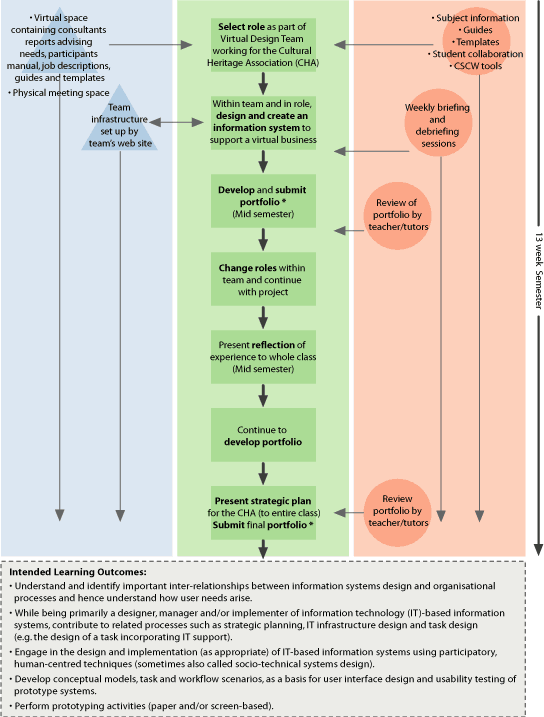|
SUPPORTS SUPPLIED
Forms of support include:
Facilitators: Academic staff to oversee
and support each two-hour session (there is one facilitator
for every approx. 18 students). The support involves "tutoring"
- if students have difficulty with certain concepts or techniques
- and debriefing - to help students see what they have achieved,
what they might plan next, and how to manage any issues with
group dynamics. The debriefing sessions help students manage
and work in this complex environment and also help them reflect
on what they are learning. Being a facilitator is a skilled
task and quite difficult - a skill that staff need to learn
and develop. One facilitator is also the lecturer-in-charge
who runs briefing and debriefing sessions (in lectures).
Co-ordinator's Manual: A Heritage Information
Co-ordinator's Manual is available to help tutors understand
their role as facilitators in this learning design.
(This is not a direct support resource for students. It is
more for those implementing this learning design.)
Participants' Manual: This serves as a
support as it explains to the students what is required of
them. It contains reference material, notes on some topics
that may be new to students, hints on how to get started,
ideas about timing, roles, deliverables and assessment. It
contains a form so that students can apply for jobs/roles
in the CHA. It contains an initial project plan for the game
and an overview of how the CHA "works". It also
contains an introduction to experiential learning and behavioural
simulations.
Guides/templates: Some templates are provided
for students to aid them in completing certain tasks - specifically
a form for recording "design rationale" - as part
of their quality management processes. Other templates are
provided to help students set up online workspaces (e.g. discussion
templates, repository templates).
Student collaboration: The fact that multiple
numbers of students work in one role enables them to collaborate
with each other and learn from each other. What this means
is that, in one game, there might be three division heads;
they can exchange ideas on how to be a manager. There might
be 15 heritage officers (the basic staff position) and they
can compare notes about how to work with/for a manager or
what method of design they are using. There are usually about
3 games running at the same time - each has a CEO and each
has a CIO and quality manager - they can also compare notes
and learn from each other. To encourage this, we require groups
to give summaries of their work to the whole class - this
is another way for students to learn from each other. Another
key event is the 10 minutes before each scheduled lecture
time. The whole class turns up and spends about 10 minutes
talking - with each CHA coordinating their own work, holding
discussions to share information, etc.
Support for this style of teaching and learning:
For many students, this style of experiential learning is
challenging and requires considerable support from staff in
this subject - and other subjects. It is important that staff
in other subjects support this style of learning even if they
are not involved in it themselves. It is also important that
this style of teaching and learning is supported more broadly
across the university, including Head of School, Dean, and
VC.
SIGNIFICANCE OF SUPPORT STRATEGIES
Support strategies are very significant. The students find
experiential learning challenging (as do the tutors/facilitators)
and need a lot of assistance and encouragement. Some really
enjoy this type of learning, others find it rather threatening.
This can often lead to problems because the simulation / game
lasts for 15 weeks. It must be managed to provide support
for the students, to re-assure them that they can deal with
the uncertainty that they initially face, and that this will
lead to valuable learning outcomes, some of which they may
not realise for years.
SUPPORT STRATEGY ADAPTATION
I think that different teachers might devise different ways
of offering support to student groups. It is quite challenging
to become a good facilitator and it might be helpful to call
on experts from your university. For example, we use a lecturer
in cultural heritage to introduce that domain of work to students.
We could use the counselling staff to talk about group work
and team building; in fact one of the psychologists does talk
to the students at a point when we feel they might appreciate
information about how to address issues of conflict, etc.
We also use tutor/facilitators who are current practitioners
(e.g. work for the government or business or are IT consultants).
Many of these people are appreciated by the students because
they speak so convincingly of how the simulation reflects
reality and offers opportunities to try new ways of working.
|
